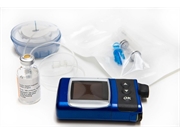Adjusting glucose thresholds for alarms linked to less time spent in hypoglycemia, hyperglycemia
TUESDAY, Nov. 26, 2019 (HealthDay News) — Adjusting glucose thresholds for hypoglycemia and hyperglycemia alarms in continuous glucose monitoring (CGM) can help achieve better glucose control in patients with type 1 diabetes mellitus, according to a study published online Nov. 19 in the Journal of the Endocrine Society.
Yu Kuei Lin, M.D., from the University of Utah School of Medicine in Salt Lake City, and colleagues examined the correlations between CGM alarm settings and glucose outcomes using data from 95 patients with type 1 diabetes.
The researchers found that use of a higher glucose threshold for hypoglycemia alarms (≥73 versus <73 mg/dL) correlated with 51 and 65 percent less time with glucose <70 and <54 mg/dL, respectively, and with significantly higher average glucose levels and less time in range; the number of hypoglycemic alarms did not increase. The optimal alarm threshold was 75 mg/dL for <1 percent of time in hypoglycemia. Lower average glucose levels were seen with lower glucose thresholds (≤205 versus >205 mg/dL) for hyperglycemia alarms, with 42 and 61 percent less time with glucose >250 and >320 mg/dL, respectively, without more hypoglycemia. There was a correlation noted for lower alarm thresholds with more alarms. The optimal alarm threshold was 170 mg/dL for <5 percent of time in hyperglycemia and hemoglobin A1c ≤7 percent.
“Our study pioneeringly demonstrated that some CGM alarm features and settings may achieve better blood sugar control for patients with type 1 diabetes,” Lin said in a statement.
Copyright © 2019 HealthDay. All rights reserved.








